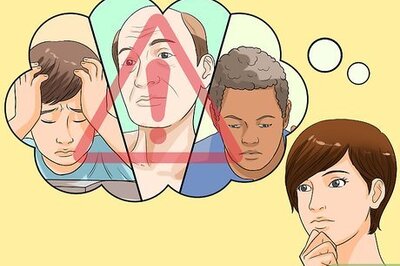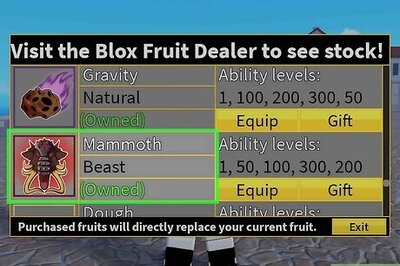
views
New Delhi: In her nearly 30 years in politics, Trinamool Congress leader and Union Railway Minister Mamata Banerjee has cut a constant figure with her humble lifestyle, exemplary personal honesty and fiery oratory.
From the time Banerjee was first elected as a Congress party MP in 1984 at the age of 29, she has had a meteoric rise in a career that has seen many ups and downs. She has held a number of ministerial portfolios before splitting from Congress to form Trinamool in 1998.
As the Congress’s most important but volatile partner, Mamata’s Trinamool Congress has played a central role in helping the party get its foothold back in a state ruled for 34 years by the communist party.
Banerjee, who sustained life-threatening injuries during a 1989 protest, triumphed on Friday at the ballot box after more than three decades of leading strikes and protests against the Communist party-led Left Front government in West Bengal.
Banerjee started her political career with the Congress in the 1970s. Her aggressive and fiery persona soon helped her rise in the party ranks and she held the post of the General Secretary of the women’s wing of the party in West Bengal between 1976 and 1980.
Banerjee first made headlines when she was sent by the party to battle one of the communists' safest seats in Kolkata in 1984. Against the odds, Banerjee delivered a shocker by beating veteran Communist party leader Somnath Chatterjee from the Jadavpur Constituency.
She lost her seat in 1989 but turned her fortune in the South Kolkata constituency seat in 1996, 1998, 1999, 2004 and 2009 General Elections.
Often temperamental, the 1990s shaped Banerjee’s political personality who, as the Sports Minister in 1992, announced her resignation led a rally at the Parade Ground in Kolkata, against the Government's indifference towards her policies.
In the late 90s her often stormy relationship with the Congress party escalated in a full blown war and she alleged that the party leaders were colluding with the Marxists for personal gains. It was at the same time that she protested the economic stagnation in the state, slammed corruption and accused the world's longest-serving democratically-elected communist government of perpetrating political violence.
Herself, a victim of political violence, Banerjee has survived attacks on her life on several occasions - both in Kolkata and in its suburbs during her many visits to the hinterland to test the pulse of the people. She was hospitalized for three months after her skull was fractured when she was punched to the ground by a communist cadre in the 1990s.
She had many run-ins with political leaders, and often in Parliament. She famously dragged an MP by his collar out of parliament to stop him protesting against a women's affirmative action bill.
Banerjee, 56, however has always claimed that she is a career politician who has never spent money on cosmetics or jewellery.
In 1997, Banerjee came out of the Congress Party and established the All India Trinamool Congress. It quickly became the fulcrum of rising power in the state with many crossing over from the communist party to join its file.
Banerjee’s alliance with the BJP-led National Democratic Alliance in 1999, that led to her being allotted the Railways Ministry, made the Congress uneasy and raises doubts on her reliability as a partner.
She has had to confront two roadblocks -- traditional Congress stalwarts scared of any threat to the Nehru-Gandhi family dynasty who tried to marginalise her, and Congress's attempts to reach out to the communists as a national coalition partner.
The woman affectionately known as ‘didi’ (elder sister), and born to a poor teacher's family, rose to become the first person capable of uniting an opposition against 34 years of communist rule in West Bengal and of leading a party, the Trinamool Congress, that could make or break Prime Minister Manmohan Singh's reform agenda.
After seven consecutive election wins, the communists have stumbled, mainly due to a badly-implemented plan to seize farming land for industry to help the state's moribund economy and provide needed manufacturing jobs. Voters saw them as stuck in a Cold War time warp and their exasperation over red tape and Marxist sloganeering has grown.
Her campaign against the communists has come to symbolize the political battles that define India today - conflicts over appropriating land for industry and infrastructure, the power of regional charismatic leaders, a growing disgust with corruption, and the push for economic reform in a country of 1.2 billion people that often resists change.
Banerjee's tale is also one of how a single woman from a humble background can succeed in this traditional society. She joins other regional leaders in India who have emerged with the decline in popularity of national parties seen as out of touch. Their populist agenda has become more influential at the centre, where national coalitions must accommodate their views as they forge India's path in a global economy.
Her manifesto is sparse, but includes introducing cruises on the Ganges River "in line with River Thames of London" and converting West Bengal's tea-growing Darjeeling district into the "Switzerland of the East".
The 56-year-old Banerjee won a landslide vote when ballots were counted on Friday to become the next leader of this state of 90 million, a population equivalent to Germany.
Unmarried, she still lives with her mother in a small bungalow with a corrugated iron roof and over time has become something of a feminist icon.
Banerjee won 19 parliamentary seats in the 2009 general election, to become the biggest party in Prime Minister Manmohan Singh's coalition government -- huge clout given the government has a parliamentary majority of just 18.
Banerjee’s popularity in the suburbs rose at the time of the decline in popularity of the communists which can be traced back to political violence against people and the heavy-handed push for industrialisation that pitted the Left Front against its once fervent grassroots supporters, the farmers.
In 2007, Tata Motors, a unit of Indian conglomerate Tata group, made a deal with the Communist government to start rolling out thousands of Nanos -- billed as the world's cheapest car -- from a new state-of-the-art factory complex in Singur.
Land was seized with little compensation and a factory wall suddenly went up, cutting farmers land in two and separating them from key irrigation pumps. The Nano itself had become a nationalist symbol and a prestigious industrial project.
Banerjee seized on the rising farmers’ agitation and soon roadblocks and street protests forced the Communists to retreat. The factory was never set up and the project moved to Gujarat in 2008.
Her party won local village elections in 2008. After the communists withdrew support from Singh's coalition government, her party filled the void in the coalition and she became railway minister in Singh's second term.
Her all but certain victory in the May 13 state elections will cap a remarkable political journey, but the road ahead poses huge challenges.
Her two-year record as railway minister has been heavily criticized for running the network into more debt to pay for populist measures such as more passenger trains.
While she has drafted in some respected advisors, including the former secretary-general of the Federation of Indian Chambers of Commerce and Industry, she is still basically a one-woman-show. (With additional information from Reuters)















Comments
0 comment